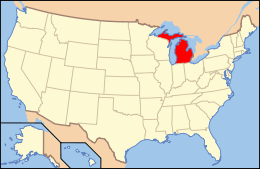Harmonie Club (Detroit, Michigan)
|
The Harmonie Club | |
|
The Harmonie Club from the south | |
| Location |
267 East Grand River Avenue Detroit, Michigan |
|---|---|
| Coordinates | 42°20′11″N 83°2′48″W / 42.33639°N 83.04667°WCoordinates: 42°20′11″N 83°2′48″W / 42.33639°N 83.04667°W |
| Built | 1894 |
| Architect | Richard E. Raseman |
| Architectural style | Beaux-Arts |
| NRHP Reference # | 80001924[1] |
| Significant dates | |
| Added to NRHP | September 4, 1980 |
| Designated MSHS | October 21, 1975[2] |
The Harmonie Club is a club located at 267 East Grand River Avenue in Downtown Detroit, Michigan. It was designated a Michigan State Historic Site in 1975[2] and listed on the National Register of Historic Places in 1980.[1]
History

Augustus Woodward's plan for Detroit's streets created oddly-shaped triangular blocks, including Capitol Park on the west and Harmonie Park on the east.[3] Starting in the 1830s and 1940s, this area was home to a growing number of German immigrants to Detroit. In 1849, to preserve their ethnic traditions, a group of Detroit Germans founded a singing group, the Gesang-Verein Harmonie.[3] The club built a frame clubhouse at the corner of Lafayette and Beaubien in 1874. This frame Harmonie Club structure burned in 1893, and the club almost immediately organized a competition, open to German architects, to design a new building. Richard Raseman (the architect of the Grand Army of the Republic Building) won the competition; the resulting building sits across from Harmonie Park.[3]
Architecture
The Harmonie Club is a four-story, hipped-roof building with a basement, built of buff-colored brick[4] and stone. The curved corner is particularly shaped to the geometry of the site.[5] The first two stories are embellished with stonework, and the top two stories feature additional banding and arched windows on the top floor.[3] Corinthian columns and a balustraded balcony over the entry add a classical feel.[5] The interior of the club features classical plasterwork, dark oak paneling and Pewabic tile.[4] The club also offered fine dining, a tavern, card rooms, bowling alley and lounges.[4]
Current use
Over time, membership in the Harmonie Club dwindled, and the club was sold in 1974.[4] The building remained vacant until the 1990s; as of 2007, the city of Detroit planned a cultural district around Harmonie Park, to include the Harmonie Club.[6] The club was recognized as an historical property by the state of Michigan in 1975, was placed on the National Register of Historic Places in 1980, and was recognized by the city of Detroit in 1988.[4]
See also
References
- 1 2 National Park Service (2008-04-15). "National Register Information System". National Register of Historic Places. National Park Service.
- 1 2 "Harmonie Club, The". Michigan State Housing Development Authority. Retrieved September 3, 2010.
- 1 2 3 4 The Harmonie Club from Detroit1701.org
- 1 2 3 4 5 The Harmonie Club from the city of Detroit
- 1 2 Eric J. Hill, John Gallagher, American Institute of Architects Detroit Chapter, AIA Detroit: The American Institute of Architects Guide to Detroit Architecture, Wayne State University Press, 2002, ISBN 0-8143-3120-3, ISBN 978-0-8143-3120-0, p. 48
- ↑ Louis Aguilar, "Harmonie Park plans get a boost," The Detroit News, March 16, 2007


